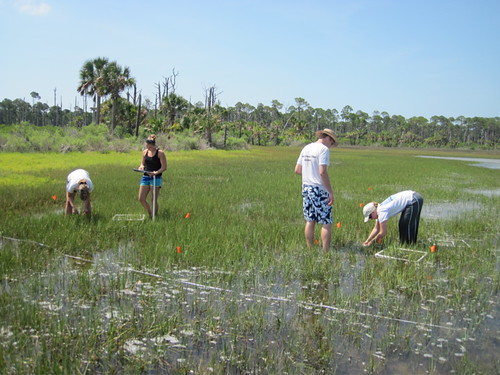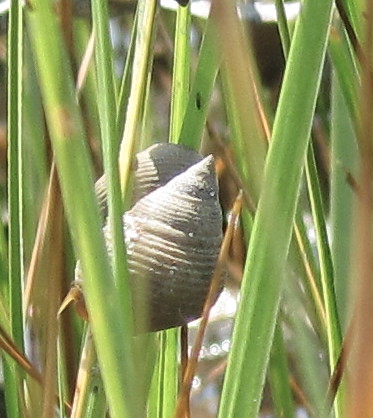Dr. Randall Hughes FSU Coastal & Marine Lab
 As a marine ecologist at the Florida State University Coastal and Marine Laboratory, my everyday job is to try to understand the plant and animal communities along our coast and then communicate that knowledge to students, other scientists, and the public. Much of my research focuses on understanding how the biodiversity, or the number of species or genetic individuals, of coastal communities such as salt marshes influences their productivity and ability to respond to disturbances. Don’t let the terminology scare you – the basic idea is similar to having a diversified stock portfolio: by having a greater variety of species or ‘genotypes,’ aka more diversity, you increase the chances that one of them will grow really well, attract lots of critters, survive a disaster, etc. Think of it as the spare tire theory of ecology!
As a marine ecologist at the Florida State University Coastal and Marine Laboratory, my everyday job is to try to understand the plant and animal communities along our coast and then communicate that knowledge to students, other scientists, and the public. Much of my research focuses on understanding how the biodiversity, or the number of species or genetic individuals, of coastal communities such as salt marshes influences their productivity and ability to respond to disturbances. Don’t let the terminology scare you – the basic idea is similar to having a diversified stock portfolio: by having a greater variety of species or ‘genotypes,’ aka more diversity, you increase the chances that one of them will grow really well, attract lots of critters, survive a disaster, etc. Think of it as the spare tire theory of ecology!
I work with undergraduate and graduate students, research assistants, and volunteers to study the marshes and seagrass beds of the FL Panhandle and Big Bend regions.
 Because large portions of the Gulf of Mexico are currently threatened by the Deepwater Horizon oil spill, this work suddenly has an increased urgency for me, personally, as well as for many other citizens who are concerned about what this oil may do to the waters, coasts, plants, and animals that we love. In this blog, I’ll give you an overview of what we’re doing in regards to the oil spill, as well as on a daily basis in the absence of major disasters, to highlight the ups and downs and funny moments associated with being a scientist.
Because large portions of the Gulf of Mexico are currently threatened by the Deepwater Horizon oil spill, this work suddenly has an increased urgency for me, personally, as well as for many other citizens who are concerned about what this oil may do to the waters, coasts, plants, and animals that we love. In this blog, I’ll give you an overview of what we’re doing in regards to the oil spill, as well as on a daily basis in the absence of major disasters, to highlight the ups and downs and funny moments associated with being a scientist.
As awareness of the magnitude of the Deepwater Horizon oil spill has increased, my lab and I have focused our efforts on documenting the current state of salt marshes in our area. This work includes identifying and counting the dominant plant species in the marsh, as well as the many marine critters (crabs or snails, such as the marsh periwinkle, below) and bugs (spiders, grasshoppers, and other insects) that live here. Bug collecting is perhaps the most attention-grabbing (as you’ll see in the video below), involving the use of a gas-powered vacuum to suck the insects into mesh bags so that we can then preserve and identify them in the lab.

Because plant genetic diversity can be very important for the ability of these plants to respond to disturbance, we’re also collecting small pieces of plant tissue that can be analyzed in the lab using DNA markers to determine how many different genetic individuals are present. Finally, we’re collecting samples of dirt to document the amount of hydrocarbons (a signature of oil exposure) in the marsh sediment. Although we still fervently hope that none of the oil reaches these marshes, such “pre-spill” data will allow us to document as completely as possible the impacts of this spill on our coast, inform the recovery of these areas, and work to prevent similar incidents in the future.

1 comment
Thank you for all you do, your work must be so rewarding. As a resident of Gulf County, I look forward to keeping up with the info posted on “In the Grass”. I watch the news fearfully everyday and pray for a solution to this horrific accident that has happened in our gulf waters.
Comments are closed.